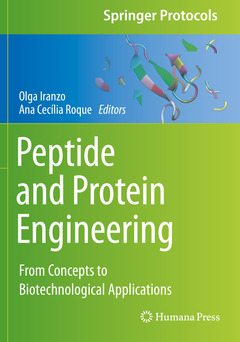Description
Peptide and Protein Engineering, 1st ed. 2020
From Concepts to Biotechnological Applications
Springer Protocols Handbooks Series
Language: English
Subjects for Peptide and Protein Engineering:
Publication date: 07-2021
289 p. · 17.8x25.4 cm · Paperback
Publication date: 07-2020
Support: Print on demand
Description
/li>Contents
/li>Comment
/li>
SEA Ligation is Accelerated at Midly Acidic pH: Application to the Formation of Difficult Peptide Junctions.- The Problem of Aspartimide Formation during Protein Chemical Synthesis Using SEA-Mediated Ligation.- Using the Interactive Tool of the Protein Chemical Synthesis Database.- Only a “Click” Away: Development of Arginine-Rich Peptide-Based Materials Using Click Chemistry.- Fluoroglycoproteins by Copper-Free Strain-Promoted Azide–Alkyne Cycloaddition.- Hybrid Silylated Peptides for the Design of Bio-Functionalized Materials.- Synthesis of Peptide-Oligoethylene Glycol (OEG) Conjugates for Multivalent Modification of Nanomaterials.- Phage Display Methodologies.- Whole-Bacterium Ribosome Display Selection for Isolation of Anti-Bacterial Affitins.- CIS Display: DNA-Based Technology as a Platform for Discovery of Therapeutic Biologics.- Building Scarless Gene Libraries in the Chromosome of Bacteria.- Streptavidin (Sav)-Based Artificial Metalloenzymes: Cofactor Design Considerations and Large Scale Expression of Host Protein Variants.- Integrated Bacterial Production of Large Combinatorial Libraries of Cyclic Oligopeptides and Functional Screening for the Identification of Chemical Rescuers of Pathogenic Protein Misfolding and Aggregation.- Site-Specific Incorporation of Non-Canonical Amino Acids by Amber Stop Codon Suppression in Escherichia coli.




